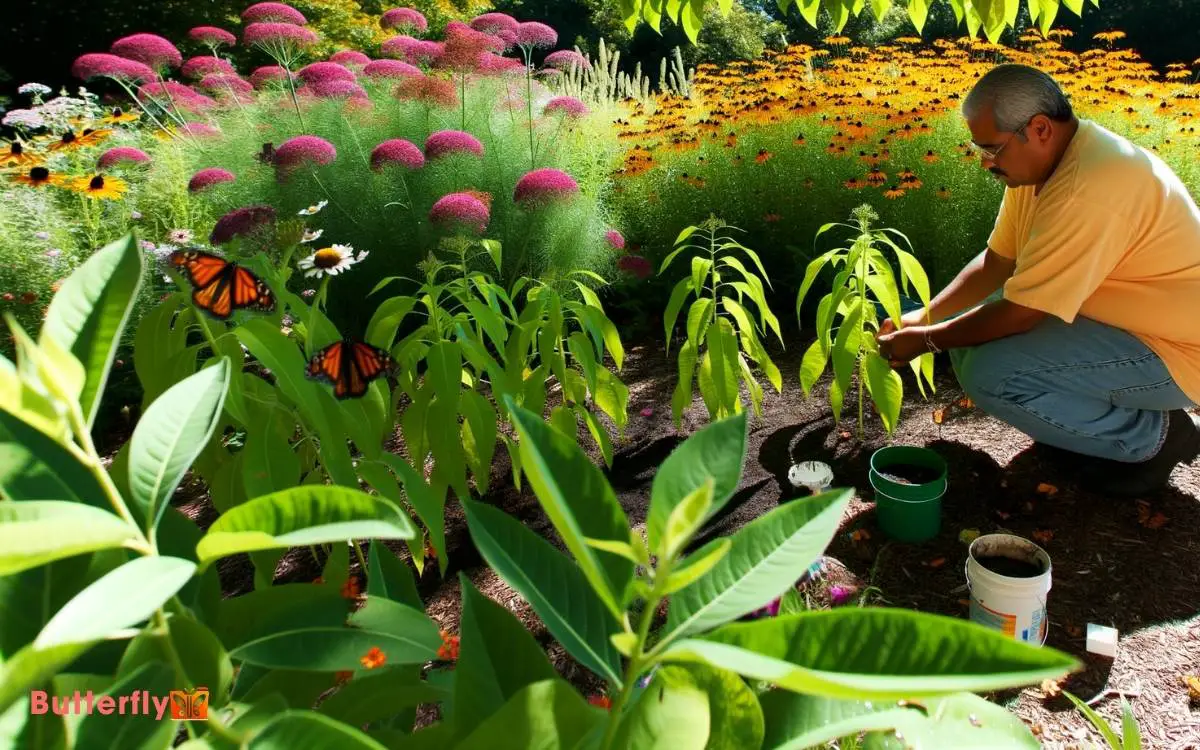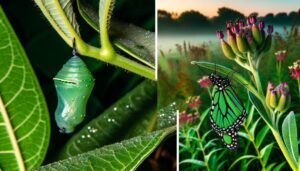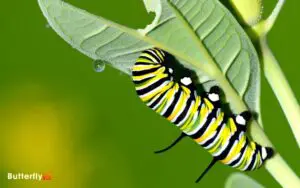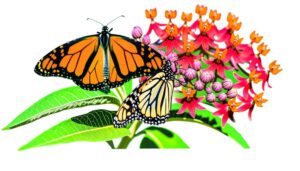How Can I Help Monarch Butterflies? Tips for Conservation
To help monarch butterflies, plant native milkweed, as it’s vital for their breeding. Opt for species like Asclepias tuberosa and Asclepias incarnata, and place them in well-drained soil under full sun.
Grow nectar-rich flowers such as coneflowers and black-eyed Susans to guarantee a continuous food source.
Avoid pesticides, especially neonicotinoids, which are harmful to monarchs. Instead, use natural pest control methods.
Also, consider participating in citizen science projects to help track monarch populations and migration patterns. By taking these steps, you’ll contribute to their conservation and discover even more impactful actions.

Key Takeaways
Plant Native Milkweed
Planting native milkweed is crucial because it provides the essential breeding habitat for monarch butterflies. You’ll find that monarchs only lay their eggs on milkweed plants, as the caterpillars feed exclusively on milkweed leaves.
When choosing milkweed varieties, select species native to your region to guarantee ideal growth and compatibility with local ecosystems.
You should plant milkweed in well-drained soil, under full sun, to mimic natural conditions. By doing so, you’ll support the entire monarch lifecycle, from egg to adult butterfly.
Additionally, avoid using pesticides, as they’re harmful to both caterpillars and adult monarchs. By planting native milkweed, you directly contribute to the conservation of this iconic species and help sustain their declining populations.
Grow Nectar-Rich Flowers
To support the diet of adult monarch butterflies, grow a variety of nectar-rich flowers that bloom sequentially throughout the seasons.
Select plants like coneflowers, black-eyed Susans, and asters, ensuring they provide a continuous food source from spring to fall.
Arrange them in clusters to make it easier for butterflies to locate the nectar. Opt for native species, as they’re more likely to meet the nutritional needs of local monarch populations.
Incorporate diverse flower shapes and colors to attract a wide range of pollinators. Maintain healthy soil and provide adequate water, as stressed plants produce less nectar.
Avoid Pesticides
Minimizing or eliminating the use of pesticides in your garden is essential for protecting monarch butterflies from harmful chemicals that can disrupt their life cycle.
Pesticides, especially those containing neonicotinoids, can be toxic to both adult butterflies and their larvae.
When you use these chemicals, you risk contaminating milkweed plants, which are vital for monarch caterpillars.
Instead, consider using natural pest control methods like introducing beneficial insects such as ladybugs or planting companion plants that repel harmful pests.
Regularly inspect your plants and manually remove any unwanted insects. By reducing pesticide use, you create a safer environment for monarchs, allowing them to thrive without exposure to substances that could impair their development and reproduction.
Create Butterfly Habitats
Creating a butterfly-friendly habitat involves incorporating native plants that provide nectar, shelter, and breeding grounds for monarch butterflies.
Start by planting milkweed, the sole host plant for monarch caterpillars. Choose native milkweed species like Asclepias tuberosa or Asclepias incarnata, which thrive in various climates.
Additionally, include nectar-rich flowers such as asters, coneflowers, and goldenrods to sustain adult butterflies. Make sure your garden has sunny spots since monarchs are cold-blooded and need warmth.
Provide shallow water sources like a damp sponge or a shallow dish with pebbles for hydration. Avoid using pesticides, as they can harm caterpillars and butterflies.
Participate in Citizen Science
Engaging in citizen science projects allows you to contribute valuable data on monarch butterfly populations and migration patterns, aiding researchers in their conservation efforts.
You can participate by joining programs like Monarch Watch, Journey North, or the Monarch Larva Monitoring Project. These initiatives often involve observing and recording sightings, tagging butterflies, or monitoring larval stages.
Your observations help scientists track changes in population sizes, migration routes, and breeding success rates.
By consistently providing thorough data, you help build a detailed database that researchers can use to identify trends and potential threats to monarchs.
Participating in these projects not only enhances scientific understanding but also empowers you to make a tangible impact on monarch conservation.
Support Conservation Efforts
To effectively support monarch butterfly conservation, you should consider donating to organizations dedicated to habitat preservation and research.
Engaging in citizen science projects can provide valuable data to researchers studying monarch populations.
Additionally, advocating for policy changes that protect migratory routes and breeding grounds is essential for their survival.
Donate to Relevant Organizations
Supporting conservation efforts through donations to organizations dedicated to protecting monarch butterflies is a crucial step in ensuring their survival.
By contributing financially, you empower these groups to continue essential work such as habitat restoration, scientific research, and public education.
Here are a few notable organizations you can consider:
| Organization | Focus Area |
|---|---|
| Monarch Joint Venture | Habitat conservation and research |
| Xerces Society | Pollinator conservation and advocacy |
| Journey North | Monitoring and tracking monarch migrations |
| Monarch Watch | Education, research, and habitat creation |
Your donations help fund projects that directly impact monarch populations.
For example, Monarch Joint Venture works on large-scale habitat restoration projects, while Xerces Society focuses on policy advocacy to protect pollinator habitats. Each organization plays a unique role in the broader conservation network.
Participate in Citizen Science
Regularly participating in citizen science projects allows you to contribute valuable data that scientists use to monitor and protect monarch butterfly populations.
By recording sightings, noting migration patterns, and tracking milkweed growth, you help create a thorough database. This data is vital for identifying trends, understanding habitat needs, and evaluating the impacts of climate change.
Consider joining platforms like Journey North or Monarch Watch, where you can easily report observations through their user-friendly interfaces. Your contributions provide real-time insights that guide conservation strategies and inform scientific research.
Engaging in these projects not only enhances your understanding of monarchs but directly supports their survival. Your active involvement ensures that conservation efforts are based on accurate, up-to-date information.
Advocate for Policy Changes
Advocating for policy changes is essential for implementing large-scale conservation strategies that can effectively protect monarch butterfly habitats.
You can influence policies by contacting local representatives and supporting legislation focused on environmental conservation.
Engage in community efforts to promote the preservation of critical habitats, such as milkweed and nectar sources.
Here are some actions you can take:
- Support conservation organizations: Donate to or volunteer with groups dedicated to monarch conservation.
- Promote sustainable agriculture: Advocate for reduced pesticide use and the implementation of organic farming practices.
- Participate in public comment periods: Provide input on proposed policies and regulations affecting butterfly habitats.
- Educate others: Raise awareness about the importance of monarch conservation through social media, workshops, or local events.
Taking these steps helps safeguard the survival of this iconic species.
Educate and Advocate
You can make a significant impact by raising community awareness about the threats facing monarch butterflies.
Promote butterfly conservation through educational programs and local advocacy initiatives.
Raise Community Awareness
One effective way to help monarch butterflies is by educating your community about their ecological importance and advocating for habitat conservation. You can organize workshops or presentations to highlight the role monarchs play in pollination and biodiversity.
Utilize social media to spread awareness and share scientific facts about their migration patterns and population decline. Collaborate with local schools to integrate monarch-related topics into their curriculum.
- Host educational events: Arrange talks, webinars, or film screenings about monarch conservation.
- Distribute informative materials: Create brochures or flyers with key information on monarchs and how to protect them.
- Engage local media: Write articles or give interviews to reach a wider audience.
- Partner with organizations: Work with environmental groups to amplify your message and resources.
Promote Butterfly Conservation
Promoting butterfly conservation requires a multifaceted approach, including rigorous scientific research, public education, and policy advocacy to guarantee sustainable habitats for monarchs.
You can contribute by educating your community about the importance of monarchs and their role in ecosystems. Advocate for policies that protect critical habitats, such as milkweed fields, which are essential for monarch reproduction.
Support initiatives aimed at reducing pesticide use, as these chemicals can be detrimental to butterfly populations. Collaborate with local conservation groups to create butterfly-friendly environments.
Participate in citizen science projects to help researchers track monarch populations and migration patterns. By combining education and advocacy, you’ll play a crucial role in ensuring the survival and thriving of monarch butterflies.
Conclusion
By planting native milkweed, growing nectar-rich flowers, and avoiding pesticides, you’re directly supporting monarch butterfly populations.
Creating butterfly habitats and participating in citizen science projects contribute valuable data for researchers.
Supporting conservation efforts and educating others amplify your impact.
With these actions, you’ll help sustain monarchs, whose survival is essential for biodiversity and ecosystem health.
Your efforts scientifically demonstrate that individual actions collectively create significant positive changes for these essential pollinators.






